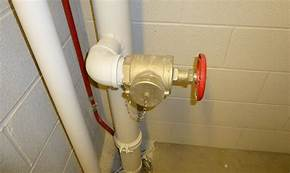Fire Service Hose-Lines and NFPA 14 Requirements

We design buildings using the codes and standards and often assume that meets the needs of the fire service. While in most cases it may, there is often some disconnect between designers and the end-user needs of these systems. To understand the needed flow and pressures required by the fire service, we start with the standards that govern fire flow requirements. The National Fire Protection Association 1710 Standard for the Organization and Deployment of Fire Suppression Operations, Emergency Medical Operation, and Special Operations to the Public by Career Fire Departments, lays out those requirements that the fire service must meet. While this standard is written for career departments, it’s the only area that addresses fire flow requirements for the deployment of fire suppression operations.
 NFPA 1710 gives us the minimum requirements for gallon per minute and the compliment of hose lines need in four basic occupant types. Single-Family, Apartment, Commercial Structure and High-Rise buildings, and provides the following as a minimum guideline:
NFPA 1710 gives us the minimum requirements for gallon per minute and the compliment of hose lines need in four basic occupant types. Single-Family, Apartment, Commercial Structure and High-Rise buildings, and provides the following as a minimum guideline:
- Single-Family – Uninterrupted 300 gpm from two hose lines with each handline flowing a minimum of 100 gpm.
- Apartment – Uninterrupted 400 gpm from three hose lines with each handline flowing a minimum of 100gpm.
- Commercial Structure (open-air strip shopping center) – Uninterrupted 500 gpm from three hose lines with each handline flowing a minimum of 150 gpm.
- High-Rise – Uninterrupted 500 gpm from two hose lines and establish a third on the floor above flowing a minimum of 250 gpm.
Once we have these numbers, we start to understand some of the system designs used by designers. For example, NPFA 14 Standard for the Installation of Standpipes and Hose Systems requires the following standpipe riser design; the first standpipe riser must flow 500 gpm from the two most remote hose connections on that riser. Each additional riser must flow an additional 250 gpm. This directly correlates with the above hose line requirements found in NFPA 1710 for both apartments and high-rise fire operations.
 The second component is the pressure requirements for the proper operation of fire service hose lines. The current requirement of 100 psi minimum and a maximum of 175 psi can be found in NFPA 14 but is not addressed in NFPA 1710. There are also several other considerations, including buildings built under the pre-1993 edition of NFPA 14 requiring 65 psi minimum, but having a maximum of 100 psi. A fire department’s maximum pumping capability also needs to be considered. This maximum level of fire department operations is key in this discussion of system design, as once above this level we must solely rely on the building’s ability to provide all flow and pressure without fire service redundancy. The fire service must be coordinated with its choice of standpipe hose and nozzle package design in order to provide optimum performance for the design pressures found in the systems they are utilizing to properly supply the flow requirements found in NFPA 1710.
The second component is the pressure requirements for the proper operation of fire service hose lines. The current requirement of 100 psi minimum and a maximum of 175 psi can be found in NFPA 14 but is not addressed in NFPA 1710. There are also several other considerations, including buildings built under the pre-1993 edition of NFPA 14 requiring 65 psi minimum, but having a maximum of 100 psi. A fire department’s maximum pumping capability also needs to be considered. This maximum level of fire department operations is key in this discussion of system design, as once above this level we must solely rely on the building’s ability to provide all flow and pressure without fire service redundancy. The fire service must be coordinated with its choice of standpipe hose and nozzle package design in order to provide optimum performance for the design pressures found in the systems they are utilizing to properly supply the flow requirements found in NFPA 1710.
